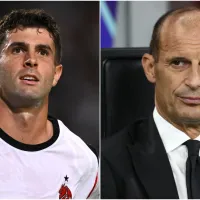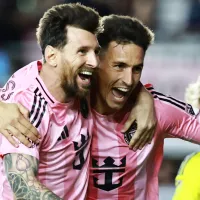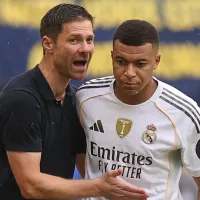An exclusive interview with Laurence Griffiths
Laurence Griffiths is an acclaimed, talented soccer photographer whose work is instantly recognized. He produced many well-known photos from France’s 2018 World Cup celebration, and he’s probably taken photos of your favorite player. He is the Editorial Content Director at Getty Images, and World Soccer Talk was lucky enough to chat with him about the ins and outs of photography.
World Soccer Talk (WST): How did you start getting into sports photography, and how did you eventually climb the ladder to becoming one of the world’s finest?
LG: My uncle, Dave Jones, was a very talented photographer based in the UK. I was sports mad as a kid and I loved playing and watching football. But it was only when Dave won an award for an amazing image of Keith Houchen scoring a spectacular headed goal during the 1987 FA Cup Final at Wembley that a career in sports photography really grabbed my attention.
Dave took me to Nottingham Forest matches when I was 16, where he gave me an old Nikon FM2, a 180mm lens and a few rolls of film at each game. He taught me the basics and helped me get my foot in the door at a local photography agency. The rest, as they say, is history. I’m now approaching my 25th year at Getty Images and covered every World Cup since 1994.
WST: What technique do you have; any rituals, rules of thumb, or tips that you follow while in the game?
LG: Preparation is key. We started planning (for World Cup 2022) soon after France lifted the trophy in 2018. At this year’s World Cup, Getty Images has a team of more than 50 people on the ground in Qatar, including 48 specialist sports photographers and operations staff. We are supported by a team of 20 editors, most of whom are stationed in London, while the others are working remotely from their home offices to live-edit the imagery in real-time. Having such great support allows our photographic team to focus on the matches and the photography.
I am traveling in Qatar with a group of five photographers to cover a game every day, so it is important to make sure that all our equipment is maintained, batteries are charged, and images are backed up after every match. We move a lot of equipment around to each match each day on top of our normal kit. We also shoot goals with our four remote and net cams, as well as from the catwalks of the stadium roofs, so we carry and wear safety harnesses and equipment.
I love football because it’s so unpredictable. You have to be on top of your game when capturing in real-time. The modern game is played so quickly with lots of one-touch football, making it by far the most difficult sport to shoot. My experience and knowledge of the game really help when capturing a World Cup. This is my 8th World Cup, so I hope I’ve learned some valuable lessons along the way!
WST: When you were shooting the Morocco-Croatia game, what did the day, in general, look like? Do you have a 24-hour timeline of what you do before, during, and after matches?
LG: Shooting a World Cup is busy and fast-paced. Morocco v Croatia seems like a long time ago now. At this year’s World Cup, all the venues are so close together, whereas, in Russia and South Africa, we were flying to each match, but this layout does allow photographers to shoot two matches a day. Once we arrive at the stadium, we give our kit a once-over before heading out to our pitch-side positions three hours before kick-off.
Our first job is to set up our two remote cameras behind the goals and attach our net cam to the back of each goal, which captures the balls crossing the line with precision. We need to do this ahead of the players coming out for their warmup. We then make sure that our cameras are connected to high-speed ethernet cables, which transmit our images to the editing team in real-time, to deliver the pictures to clients in as little as 30 seconds.
The first thing that really struck me about this fixture was the amazing support from the Morocco fans. They were colourful, vibrant, noisy and bathed in sunlight as it was the early 1pm (local time) match. I made it my priority to document those scenes. Sadly, they didn’t get a goal to cheer about as the game ended 0-0, but at least it was a vital point in the group stage. Football photography is all about big moments, goals, celebrations and reactions, so a 0-0 draw was far from ideal for the fans.

WST: What’s your favorite soccer picture of all time that you’ve taken?
LG: There are so many elements that have to come together to make a great football photograph. My favourite image from a World Cup is of Paul Pogba kissing the trophy after winning the 2018 World Cup. I love the fact that he is hugging and kissing the trophy as if it were his child.
WST: Photographers are always in the background during broadcasts. But is there one time a player interacted with you while you were on your job?
LG: Getty Images has been the authorized photographic agency of FIFA since 2009, so we have had plenty of player interactions over the years. We shoot exclusive content for FIFA, including portraits of every single player who takes the field at the World Cup, and you can see how much the players enjoy these shoots from the images we capture.
I was lucky enough to shoot the portraits of the French team ahead of them winning the World Cup in 2018. They were the most fun team I’ve ever shot. Pogo (Paul Pogba) and Mbappé were on top form that day.
WST: Is there any other important information you feel World Soccer Talk readers should know?
LG: In total, we will capture 1.5 million images at this year’s World Cup and upload more than 3,000 images each day to GettyImages.com. Thanks to our unique access, we can take coverage of the event to the world from the most exclusive positions, providing behind-the-scenes photos from every angle including the locker room, player’s tunnel and near the team benches.
Photo credit: Laurence Griffiths – FIFA/FIFA via Getty Images; Photographs used with permission of Laurence Griffiths.














